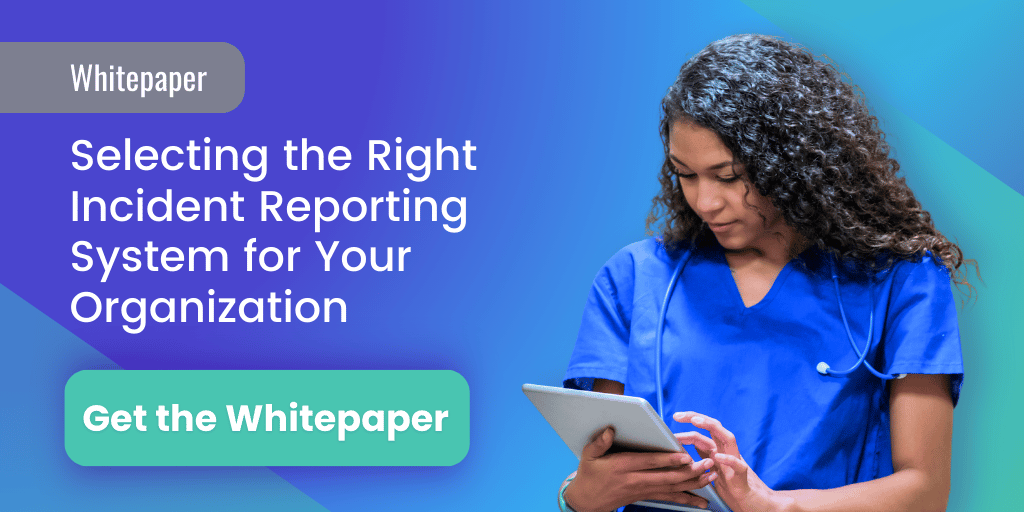4 min read
7 Incident Reporting in Healthcare Applications
Performance Health Partners
April 8, 2024

Incident reporting in healthcare is a crucial component for identifying contributing factors to incidents, improving patient and staff safety, and ensuring organizational transparency. Incident reporting software offers an effective solution for healthcare organizations by simplifying safety event data collection and sharing. It can also be used to track and manage various types of healthcare incidents, streamlining the internal process for handling each. Here is an expanded overview of seven types of healthcare incident reporting applications.
1. Patient-Related Incidents
Ensuring patient safety and quality care requires the prompt and meticulous documentation of patient-related incidents, including events such as patient falls and healthcare-acquired conditions. It is essential to foster a culture of safety within healthcare settings, where all incidents are reported accurately and immediately.
Following safety incidents and near misses, immediate follow-up actions are necessary. A thorough and inclusive documentation process is essential, integrating insights from all relevant stakeholders: the patients themselves, their families, and the healthcare personnel involved. This collective approach aids in capturing a comprehensive view of the incident from multiple perspectives.
Furthermore, when patient harm has occurred, it's critical to perform a root cause analysis to understand the underlying factors contributing to the incident. By implementing a robust and thorough reporting strategy from the outset, healthcare providers can ensure a comprehensive examination of each incident.
This strategy not only facilitates a deeper understanding but also enhances transparency and accountability within the healthcare environment. Ultimately, this process builds trust among patients, their families, and healthcare professionals, thereby strengthening the overall patient care system.
2. Staff-Related Incidents
Incidents affecting staff, such as needlestick injuries or workplace violence, require insight to improve training and standards. The establishment and promotion of a just culture, wherein staff can openly report incidents without the fear of reprisal, stand as crucial pillars in fostering a culture of safety and accountability.
Reporting staff incidents serves a dual purpose: immediate documentation for resolution and a valuable avenue for continuous learning and enhancement.
Fostering a culture of incident reporting creates a dynamic platform for ongoing improvement by:
- Addressing immediate issues
- Exploring root causes
- Identifying trends and patterns in safety events
- Implementing preventive measures
This comprehensive approach to healthcare incident reporting creates a robust foundation for preventing future incidents and ultimately ensuring the well-being of both staff and patients.
3. Complaints by Patients or Family
Addressing and recording complaints is crucial as they can stem from diverse situations, often rooted in miscommunication. Effectively managing these issues becomes important in mitigating potential legal and reputational risks for healthcare organizations. Streamlining the process through integrated complaint and incident reporting software proves instrumental in connecting related events, facilitating more efficient management.
By providing a platform for patients or their families to voice concerns and complaints, healthcare organizations not only acknowledge the importance of patient autonomy but also foster an active and open dialogue. This two-way communication not only enhances patient satisfaction but also strengthens the relationship between healthcare providers and the communities they serve. The transparency offered by such a system builds trust, allowing organizations to address concerns promptly and demonstrate their commitment to delivering high-quality, patient-centered care.
Moreover, understanding the root causes of complaints empowers staff to make effective improvements. By analyzing the underlying issues, healthcare professionals can implement targeted changes in communication, processes, or protocols, leading to enhanced service delivery and overall patient experience.
4.Incidents of Workplace Violence
In the United States, healthcare workers are five times more likely to experience a workplace violence injury than workers in other industries. Aside from physical harm, violent and aggressive incidents can result in psychological trauma, increased staff burnout, and reputational damage to the organization.
Immediate reporting allows for a streamlined investigation process as well as follow-up support for affected staff. It is important to prioritize staff support post-aggressive and violent events as healthcare workers may be at higher risk of developing PTSD and other psychological effects due to their line of work.
Ensuring the mental well-being of healthcare workers helps to improve their performance, employee engagement, and overall job satisfaction.
5. Information Security Incidents
Data breaches in healthcare pose significant legal, reputational, and financial risks.
According to an IBM report, the average cost of a data breach in 2019 was $3.92 million, while a healthcare industry breach typically costs $6.45 million.
The follow-up procedures for reporting and analyzing information security incidents differ from those for patient- or staff-related incidents, and regulatory compliance regarding data security is rigorously enforced.
Despite the prevalence of cyber-attacks in healthcare, organizations can implement preventive measures to avoid data breaches. Utilizing incident reporting software is a key step in creating and testing security incident response plans. This not only aids organizations in proactively preventing security threats by identifying and addressing gaps beforehand but also ensures that a swift incident response plan can contain security breaches and mitigate potential damage.
6. Medical Equipment Failures
When medical equipment fails, there are serious implications which can include the cancelation or delay of critical procedures or significant harm to staff or a patient. In critical care situations, this is especially harmful as equipment failure can result in patient death.
Reporting incidents related to equipment malfunctions is crucial for patient safety. Reporting equipment malfunctions proactively prevents potential harm to patients and staff by identifying near misses. These near misses represent instances where a malfunction, though not causing harm directly, could have been caused under slightly different circumstances. Healthcare professionals contribute to a proactive safety approach by utilizing incident reporting software and identifying vulnerabilities before they escalate.
7. Medication Errors
The Institute of Medicine reports that medication errors are estimated to cause approximately 7,000 deaths in the United States each year.
A strong reporting system enables healthcare organizations to identify patterns in medication errors and implement targeted corrective measures, improving patient safety through enhanced protocols and training programs. The goal is to minimize errors and ensure continuous improvement in medication management.
In addition to these applications, healthcare organizations should consider moving away from paper-based systems and instead adopt incident reporting software for real-time data, crucial for safety and compliance.
By adopting an incident reporting process, organizations gain access to a dynamic and real-time data collection and analysis system. This not only streamlines the healthcare incident reporting process but also enhances the overall efficiency of incident management protocols. Real-time data is indispensable in healthcare for making informed decisions promptly, especially in critical situations where swift responses are crucial.
Ready to Get Started?
Learn how Performance Health Partners’ incident reporting software can help your organization improve patient safety. Click here to get started.



